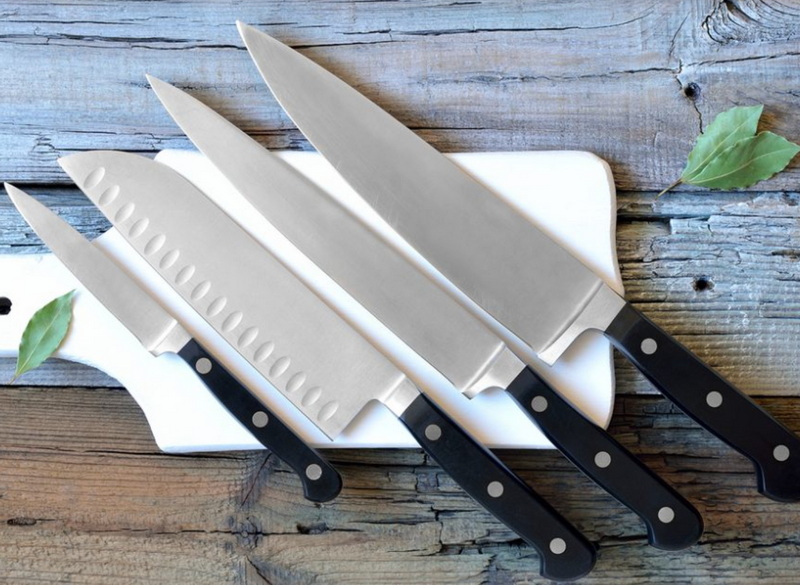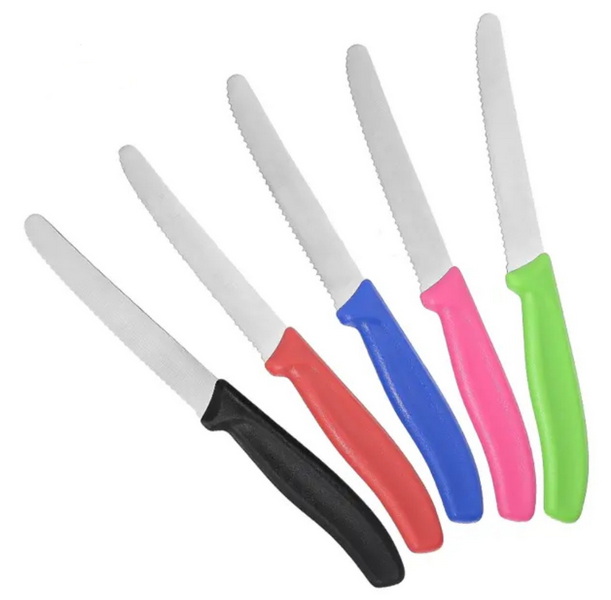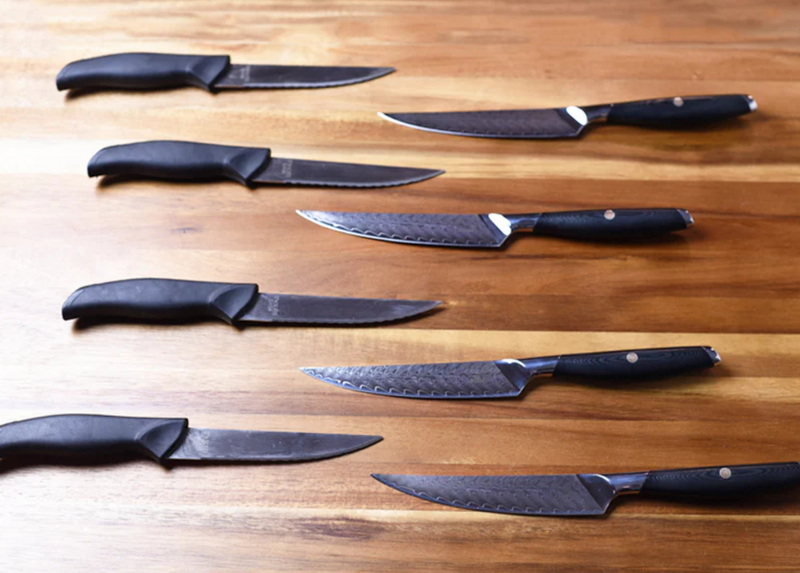- All
- Product Name
- Product Keyword
- Product Model
- Product Summary
- Product Description
- Multi Field Search
Views: 222 Author: Ann Publish Time: 2025-10-28 Origin: Site











Content Menu
● Blade material and hardness: the foundation of performance
● Edge geometry and manufacturing precision
● Handle design: grip, balance, and aesthetics
● Balance, weight, and perceived quality
● Durability, corrosion resistance, and maintenance
● Craftsmanship, fit, and finish
● Performance in real-world use: efficiency and control
● OEM considerations for scalable production
>> 1) Design strategy for market segments
>> 2) Manufacturing controls and QC
>> 3) Customization options for brands
>> 4) Packaging and presentation
● Brand storytelling and marketing angles
● Safety, care, and maintenance essentials
● SEO considerations and keyword stewardship
>> What is the best blade steel for a steak knife?
>> Why is a full tang important in a steak knife?
>> How should I maintain my steak knife to keep it sharp?
>> Are Damascus-steel steak knives worth the investment?
>> What is the ideal edge angle for a steak knife?
Investing in a high-quality steak knife is more than a purchase; it is a commitment to dining excellence, culinary precision, and lasting value for your kitchen toolkit. For brands, wholesalers, and manufacturers offering OEM solutions, the right steak knife portfolio can differentiate your line in a crowded market. This extended section expands on the practical and technical considerations that define quality, with a deeper dive into materials, manufacturing, and user experience.

A premium steak knife demands a blade that combines edge retention with corrosion resistance. High-carbon stainless steels such as 1.4116, 440C, and premium Japanese stainless alloys provide a robust balance. For OEM programs targeting luxury segments, consider layered or Damascus-style blades for aesthetic appeal and distinctive brand signatures, while maintaining predictable performance through consistent heat treatment. Heat treatment parameters—annealing, quenching, and tempering—determine hardness, toughness, and grain structure, which in turn influence edge stability during long service periods.
The geometry of the edge directly affects slicing efficiency and user satisfaction. For most steak knives, edges are honed to a sharp, uniform burr with a micro-bevel to reduce chipping and improve resilience against minor knicks. Laser-guided grinding tolerances help achieve repeatable edge profiles across large production runs, a critical factor for OEM programs that require consistent quality across batches. Consider offering varying edge angles within your product family to match different price tiers and target markets, while preserving a recognizable brand signature.
Handle materials range from durable plastics like PP, POM, and ABS to premium options such as G10, micarta, and stabilized woods. The choice of handle material influences grip texture, moisture management, and longevity under dishwasher impact. Ergonomic contouring, a comfortable palm swell, and a secure full tang construction contribute to fatigue reduction during extended use. For OEM projects, a cohesive handle language across multiple knife lines strengthens brand identity and enables efficient mass production.
A well-balanced steak knife feels like an extension of the hand. Weight distribution, center of gravity, and tang-to-handle transitions contribute to perceived quality and cutting confidence. In manufacturing terms, maintaining precise tang geometry and a flush bolster-to-hinish transition reduces user perception of roughness and enhances the premium feel. Balancing features can be adjusted through bolster design, handle thickness, and blade geometry, providing OEM teams with scalable options to meet different market expectations.
Stainless steel blades resist staining and corrosion, a crucial factor in household kitchens and professional environments alike. Surface treatments, such as coatings or micro-sanding to reduce drag, can enhance both performance and aesthetics. The maintenance routine for premium steak knives should be clearly communicated to buyers: hand washing, thorough drying, and periodic honing with tools designed for kitchen blades. Transparent maintenance guidance supports brand trust and reduces user frustration, important for long-term OEM success.
Quality indicators include blade-to-handle alignment, consistent thickness across the blade, and uniform polishing. Subtle design cues—such as a gentle transition from blade to tang, a precise edge bevel, and a refined bolster contour—signal high craftsmanship. For OEM collaborations, establish and audit standard operating procedures (SOPs) for grinding, beveling, polishing, and assembly to ensure uniformity across production lots.
A high-quality steak knife should enable fast, clean slicing with minimal resistance, precise control for vertical and horizontal cuts, and comfortable handling during service. Real-world testing scenarios—slicing through different meat textures, applying varying cutting angles, and performing long-duration tasks—provide practical benchmarks for product development and marketing narratives. Documenting these results with video demonstrations helps international buyers visualize performance and reinforces your product claims.

- Entry-level premium: solid stainless blade, standard plastic handle, reliable edge geometry.
- Mid-range: enhanced blade steel, refined handle materials, and a more refined finish.
- Luxury: Damascus or layered steel aesthetics, premium handle materials, and customizable branding.
- Steel sourcing with traceability and supply chain transparency.
- Controlled heat-treatment cycles to achieve consistent hardness and toughness.
- In-line inspection for blade thickness, edge uniformity, and finish grade.
- Final QA checks including edge retention tests and corrosion resistance assessments.
- Logo engraving on blade or handle, laser etching on packaging, and color-matched accents.
- Private-label packaging designs that align with retailer branding.
- Optional built-in sharpeners or knife blocks integrated into the product line for cross-selling.
- Protective, tamper-evident packaging with clear usage instructions.
- Visual storytelling through photography and product videos to showcase edge quality and ergonomic design.
- Eco-friendly packaging solutions to appeal to sustainability-focused buyers.
- Clear labeling of material specifications and care guidelines.
- Compliance with regional safety standards and labeling requirements.
- Robust warranty terms that reflect confidence in the product's durability.
- Emphasize precision, edge retention, and long-term value as core benefits.
- Use high-quality close-ups of the blade edge and grip texture to communicate craftsmanship.
- Provide multimedia content: slicing demonstrations, maintenance tutorials, and lifestyle scenes in premium kitchen settings.
- Localization strategies to adapt messaging for different markets while preserving a consistent global brand voice.
- Hand wash preferred; avoid prolonged soaking and dishwasher exposure for premium handles.
- Use blade-specific sharpeners to maintain a consistent edge without altering geometry.
- Dry thoroughly after washing to prevent moisture-related corrosion.
- Store in protective blocks, sleeves, or magnetic strips to minimize nicks and chipping.
- Primary keyword: Steak Knife.
- Supporting terms: high-quality steak knife, forged steak knife, private label steak knife, OEM steak knife, meat-slicing knife, kitchen cutlery.
- Integrate keywords naturally in headings and body text; avoid stuffing.
- Include long-tail phrases to capture niche queries from professional buyers and OEM partners.
A high-quality steak knife blends material science, precise manufacturing, ergonomic design, and compelling brand storytelling. The choice of blade steel, heat-treatment, edge geometry, and handle material all contribute to edge retention, cutting efficiency, and user comfort. For OEM programs, establishing standardized processes, transparent material sourcing, and consistent quality control is essential to deliver reliable performance across markets. Thoughtful packaging, clear care guides, and engaging multimedia content help translate technical excellence into buyer confidence and long-term brand loyalty. A well-executed steak knife line not only meets functional expectations but also elevates the dining experience, reinforcing the value of investing in premium cutlery for both professional kitchens and discerning home cooks.

The best blade steel for a steak knife is high-carbon stainless steel, such as 1.4116 or 440C, which offers excellent edge retention and corrosion resistance. Premium options may include layered or Damascus steels for added aesthetics and durability.
A full tang provides better balance, strength, and durability. It ensures the blade and handle are securely connected, reducing the risk of breakage and improving overall control during use.
Hand wash your steak knife, dry it thoroughly, and avoid dishwasher exposure. Use a blade-specific sharpener regularly to maintain the edge, and store the knife in a protective block or sleeve to prevent nicks.
Damascus-steel steak knives offer distinctive patterns and enhanced toughness, making them a worthwhile investment for those seeking both performance and visual appeal. However, they require careful maintenance to preserve their finish.
The ideal edge angle for a steak knife is typically between 15 and 20 degrees per side. This angle provides a sharp, efficient edge that slices through meat smoothly while maintaining durability.
The Ultimate Professional Knives for Halal Butchery in Middle Eastern Kitchens
Chef Knife Size Guide: Choosing Between 6″, 8″, 10″, And 12″
Custom Knife Handles: How To Design A Chef Knife That Fits Your Hand Perfectly
Chef Knife Surface Treatments Guide: From Polished Migaki To Damascus Patterns
Inside Our Professional Knife Sample Room: Quality You Can See
Universal Knife Block Buying Guide: Modern Acrylic & ABS Knife Holders for Professional Kitchens
Universal Knife Block: The Complete Guide To Modern, Hygienic Knife Storage
The Complete Guide To Red Handle Knife Sets: Style Meets Functionality in The Kitchen
Professional Knives for Halal Butchery And Middle Eastern Cuisine